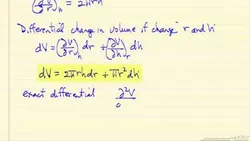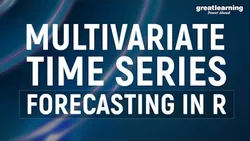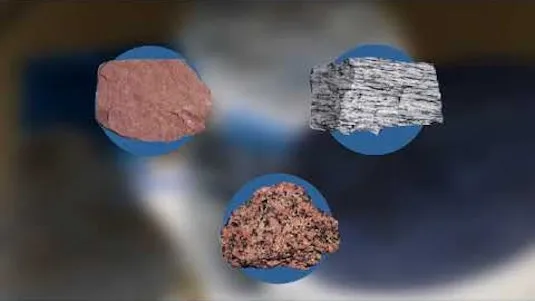
Thermodynamics: Generalized Analysis of Fluid Properties 
This course covers the generalized analysis of fluid properties, including exact differentials and partial derivatives, Maxwell relations, state functions, heat capacity pressure dependence, three parameter equation of state, van der Waals equation of state, isothermal compression of a non-ideal gas, real gas expansion, enthalpy departure function for throttle feed, fugacity introduction, steam fugacity, single component solid-vapor equilibrium, chemical potential pressure and temperature dependence, and single-component pressure-temperature diagram. ▼
ADVERTISEMENT
Course Feature
![]() Cost:
Cost:
Free
![]() Provider:
Provider:
Youtube
![]() Certificate:
Certificate:
Paid Certification
![]() Language:
Language:
English
![]() Start Date:
Start Date:
On-Demand
Course Overview
❗The content presented here is sourced directly from Youtube platform. For comprehensive course details, including enrollment information, simply click on the 'Go to class' link on our website.
Updated in [February 21st, 2023]
Exact Differentials & Partial Derivatives.
Maxwell Relations.
State Functions and Maxwell Relations.
Heat Capacity Pressure Dependence.
Three Parameter Equation of State (EOS) Introduction.
Van der Waals Equation of State.
Isothermal Compression of a Non-Ideal Gas.
Isothermal Compression of a Non-Ideal Gas (Spreadsheet).
Real Gas Expansion.
Real Gas Expansion Part 2: Excel Solver.
Roots of Peng-Robinson Equation of State.
Adiabatic Compressor: Non-Ideal Gas.
Peng-Robinson EOS Spreadsheet 1.
Peng-Robinson EOS Spreadsheet 2.
Enthalpy Departure Function for Throttle Feed.
Departure Function: van der Waals Fluid.
VLE in a Constant-Pressure System.
Heat of Vaporization: Clausius-Clapeyron.
Heat of Vaporization: Antoine's Equation.
Gibbs Free Energy Pressure Dependence.
Gibbs Free Energy: T & P Dependence.
Fugacity Introduction.
What is Fugacity?.
Which has the Higher Fugacity?.
Calculate Fugacity of a Fluid.
Steam Fugacity.
Add Liquid to an Evacuated Tank.
Single Component, Solid-Vapor Equilibrium.
Fugacity of a Single Component.
Fugacity Temperature Dependence: Single Component.
Determine Pressure using Peng-Robinson EOS Spreadsheet.
Saturation Pressure from EOS Spreadsheet.
Calculate Fugacity from Equation of State.
Condense Water Vapor from Air.
COSMOtherm: Visualizing Molecular Interactions.
COSMOtherm: Molecular Interactions Probability.
SRK Equation of State Example.
Chemical Potential: Pressure Dependence for Single-Component Part 1.
Chemical Potential: Pressure Dependence for Single-Component Part 2.
Chemical Potential: Pressure Dependence for Single-Component Part 3.
Chemical Potential: Temperature Dependence for Single-Component Part 1.
Chemical Potential: Temperature Dependence for Single-Component Part 2.
Chemical Potential: Temperature Dependence for Single-Component Part 3.
Single-Component Pressure-Temperature Diagram.
Introduction to Nonlinear Regression.
Derivation of Clapeyron and Clausius-Clapeyron Equations.
(Please note that we obtained the following content based on information that users may want to know, such as skills, applicable scenarios, future development, etc., combined with AI tools, and have been manually reviewed)
Learners can learn from Thermodynamics: Generalized Analysis of Fluid Properties in a variety of areas. Firstly, they can gain an understanding of exact differentials and partial derivatives, as well as Maxwell relations and state functions. They can also learn about heat capacity pressure dependence, three parameter equation of state (EOS) introduction, Van der Waals equation of state, isothermal compression of a non-ideal gas, real gas expansion, and roots of Peng-Robinson equation of state.
In addition, learners can explore enthalpy departure function for throttle feed, departure function for van der Waals fluid, VLE in a constant-pressure system, heat of vaporization, Gibbs free energy pressure dependence, and Gibbs free energy temperature and pressure dependence. They can also learn about fugacity introduction, what is fugacity, single component solid-vapor equilibrium, fugacity temperature dependence, and calculate fugacity of a fluid.
Finally, learners can gain an understanding of steam fugacity, add liquid to an evacuated tank, condense water vapor from air, COSMOtherm visualizing molecular interactions, SRK equation of state example, chemical potential pressure dependence for single-component, and single-component pressure-temperature diagram. They can also learn about introduction to nonlinear regression and derivation of Clapeyron and Clausius-Clapeyron equations.
[Applications]
Upon completion of this course, students should be able to apply the concepts of thermodynamics to analyze fluid properties. They should be able to use exact differentials and partial derivatives, Maxwell relations, state functions, and the three parameter equation of state (EOS) to calculate heat capacity, pressure dependence, and real gas expansion. Additionally, students should be able to use the van der Waals equation of state, Peng-Robinson equation of state, and the Clausius-Clapeyron equation to calculate enthalpy departure functions, vaporization heat, Gibbs free energy, and fugacity. Furthermore, students should be able to use COSMOtherm to visualize molecular interactions and the SRK equation of state to calculate chemical potential. Finally, students should be able to use nonlinear regression to derive the Clapeyron and Clausius-Clapeyron equations and create single-component pressure-temperature diagrams.
[Career Paths]
Three job positions that could be recommended to learners of this course are:
1. Thermodynamics Engineer: Thermodynamics engineers use the principles of thermodynamics to design and develop systems and processes that convert energy into useful forms. They analyze the performance of existing systems and processes, and develop new ones to improve efficiency and reduce costs. They also develop models to predict the behavior of systems and processes, and use computer simulations to test their designs. The development of new energy sources and technologies is driving the demand for thermodynamics engineers.
2. Process Engineer: Process engineers are responsible for designing, developing, and optimizing industrial processes. They analyze existing processes and develop new ones to improve efficiency and reduce costs. They also develop models to predict the behavior of processes, and use computer simulations to test their designs. Process engineers must have a strong understanding of thermodynamics, as well as other engineering disciplines such as chemical engineering, mechanical engineering, and electrical engineering.
3. Energy Analyst: Energy analysts use their knowledge of thermodynamics and other engineering disciplines to analyze energy systems and processes. They develop models to predict the behavior of systems and processes, and use computer simulations to test their designs. They also analyze existing systems and processes, and develop new ones to improve efficiency and reduce costs. Energy analysts must have a strong understanding of thermodynamics, as well as other engineering disciplines such as chemical engineering, mechanical engineering, and electrical engineering.
Course Provider

Provider Youtube's Stats at AZClass
Discussion and Reviews
0.0 (Based on 0 reviews)
Explore Similar Online Courses

Beginner Android Programming (Java)

Multivariate Time Series Forecasting In R Data Analytics With R Data Science Great Learning

Python for Informatics: Exploring Information

Social Network Analysis

Introduction to Systematic Review and Meta-Analysis

The Analytics Edge

DCO042 - Python For Informatics

Causal Diagrams: Draw Your Assumptions Before Your Conclusions

Whole genome sequencing of bacterial genomes - tools and applications

Viscous Fluid Flow

Metamorphic Petrology & Thermodynamics


Start your review of Thermodynamics: Generalized Analysis of Fluid Properties